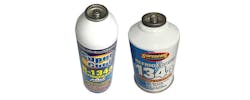Evidently those words were never spoken to the mobile air conditioning industry, because once more we are in the midst of more changes. One of the changes we explained in a previous article — the new R-1234yf refrigerant. The other change in air conditioning revises the sealing design on small cans for all refrigerants, including R-134a. First, let’s examine the progress of OEMs updating to R-1234yf systems.
A Quick Review
In our last article on this subject, we outlined some important facts in the R-1234yf program. They included: R-1234yf is totally different than R-134a and requires different maintenance or service equipment, as well as some unique service fluids.R-1234yf fittings are a new design that will not allow a technician to perform the service without the proper equipment.
R-1234yf is somewhat flammable, and precautions must be made in the work area to prevent sparking or ignition.
We thought R-1234yf was going to be introduced during a very slow process, usually as new models are introduced or updated. We were incorrect in that assumption. The change is coming much more quickly than the vehicle manufacturers initially indicated.
What vehicles use R-1234yf today?
The European vehicle manufacturers were first on board with the new type refrigerant, and many of their models are currently equipped with R-1234yf. In fact, all Volkswagen, Land Rover and Jaguar models now come with R-1234yf. BMW announced starting in 2017, as new models were introduced, they would feature the new refrigerant (BMW’s X1, X3 and i-models now have it). Volvo has incorporated it in the S80, V70 and XC90. But how about the Asian manufacturers?Honda has incorporated the R-1234yf systems on the Civic, Pilot and Ridgeline — with more models slated to update as they are reintroduced. It can also be found in the Toyota Tacoma and in the Lexus line on the GS, LS, NX and RC. But the most aggressive manufacturer pushing the change in Asia is Kia – utilizing the new system in Cadenza, Optima, Sorento, Soul and Sportage. If you are considering adding this service, the real kicker comes from the US manufacturers.
Cadillac led the R-1234yf charge, but now it is found on Ford F-150, Chevy Silverado and Colorado — and the GMC Sierra and Canyon. If that is not enough to pique your interest, you can add these models to the list:
- Cadillac ATS, CTS and XTS
- Chevrolet Malibu, Spark and Trax
- Chrysler 200, 300 and Pacifica
- Dodge Challenger, Charger and Durango
- Ford Escape, Fusion, Mustang and Transit
- Ram 1500
What additional inventory is needed?
Besides the obvious equipment requirements, R-1234yf requires its own unique PAG oil. The correct PAG oil is “considered critical in terms of stability and solubility,” to quote one industry publication. Regarding leak detection dyes, if the ultraviolet dye you use is tested and certified safe in accordance with SAE J2297 (latest revision January, 2013), it will not harm seals or lubricants and can be used for either refrigeration system. In addition, the leak detection equipment must meet the current SAE J2913 standard, which was revised in October of 2016 to correctly detect leaks in R-1234yf systems.What other industry changes are occurring?
The EPA has issued a new restriction, “All small cans of refrigerant (under two pounds) produced after January 1, 2018, must come equipped with a self-sealing valve capable of preventing the container from venting refrigerant after it is removed from the charging valves.”The design of the seal on the small cans (any type refrigerant) is required to be a new design — a self-sealing valve. In the past, the refrigerant was accessed in the can through a piercing valve. A tool with a hose punctured the seal at the top of the can, but it could not be re-sealed. The piercing hose assembly had to remain on the can. If you removed the hose, you would lose any remaining refrigerant. The new design is more environmentally responsible and allows the tool to be removed from the can without losing the remaining contents. Note that the hose assembly tool that was used on the old style cannot be used on the new self-sealing valve. It will require a new tool designed specifically for the self-sealing valve.
[lgc_column grid="50" tablet_grid="50" mobile_grid="50" last="false"]
[lgc_column grid="50" tablet_grid="50" mobile_grid="50" last="true"]
Even though they look similar upon initial inspection, the two different styles of can are visually identifiable. Photo 1 shows the old-style piercing valve. The inner portion of the valve is small, since the piercing point of the tool requires a small area to puncture the seal. Photo 2 highlights the new self-sealing valve. The center section is larger and flat, allowing the new tool to push the seal down without damaging the seal. When the tool is removed from the can, the flat seal pushes up and prevents any of the contents from leaking out. This will also enable the technician to use all of the contents of every can without any going to waste. On another note, Hybrids are continuing to grow in popularity.
So keep in mind some HVAC systems used in hybrid vehicles require different fluids than standard systems. Some hybrid systems have used a scroll compressor, which can be powered via a belt when the engine is running or electrically when the engine is off. Most of the newer hybrids have changed to an inverter compressor, which is powered by a high-voltage electrical motor, so compressor operation does not depend on the engine. You must use the proper compressor oil, or you will end up replacing every component in the HVAC system.
Also, PAG oil-based florescent dye should not be added to the electrical compressor systems found in hybrids due to electrical conductivity. Hybrid vehicle leak-detection dye is polyolester-based and is specific to hybrid vehicles. The R-134a leak dye used for some non-hybrid electric vehicles uses PAG oil, which is hygroscopic. Using it in a hybrid vehicle, even in the smallest amount, can create an air conditioning compressor failure.
These are some of the current changes that present opportunity in the eyes of the successful auto service facility. Knowing what the future brings presents you a golden opportunity to plan for success.
In the words of John F. Kennedy, “Change is the law of life. And those who look only to the past or present are certain to miss the future.”
About the Author

